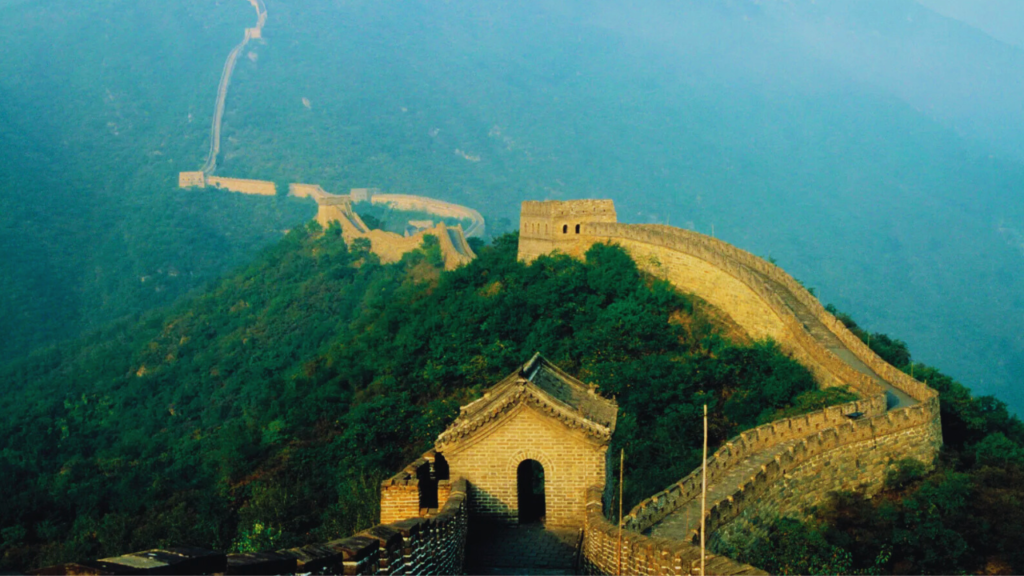
Great Wall of China : Historical Significance
The Great Wall of China is a remarkable series of fortifications constructed to defend against nomadic invasions from the Eurasian Steppe. Its origins date back to the 7th century BC, with various walls built by different states. The first emperor of China, Qin Shi Huang, connected several existing walls around 220–206 BC, although little of his structure remains today.

Over the centuries, subsequent dynasties expanded and reinforced the wall, with the most famous sections constructed during the Ming Dynasty (1368–1644). This period saw the use of advanced materials like bricks and stone, leading to a more durable and formidable structure. The Great Wall not only served as a military defense but also facilitated trade and controlled immigration, symbolizing China’s historical strength and unity. Today, it stands as a UNESCO World Heritage site and an iconic representation of Chinese culture.
The Great Wall of China, an iconic symbol of ancient engineering, served various purposes beyond mere defense. Its extensive structure facilitated border control, allowing for the regulation of trade along the Silk Road by imposing duties on goods. This control also extended to managing immigration and emigration, making the Wall a crucial element in the economic and social landscape of ancient China.

To enhance its defensive capabilities, the Wall was equipped with numerous watchtowers, troop barracks, and garrison stations, providing strategic vantage points for monitoring movements along the frontier. Signaling systems, utilizing smoke or fire, allowed for rapid communication between different sections of the Wall, ensuring a coordinated response to threats. Additionally, the Wall’s path functioned as a transportation corridor, linking various regions and fostering trade and interaction.
Constructed by different dynasties over centuries, the Wall spans an impressive 21,196.18 km (13,170.70 mi), stretching from Liaodong in the east to Lop Lake in the west, and forming an arc that delineates the edge of the Mongolian steppe. Today, it is celebrated not only for its historical significance but also for its remarkable architectural achievements, solidifying its status as one of history’s most impressive structures.
History of the Great Wall of China
The Great Wall of China began as fortifications built by various states during the Spring and Autumn and Warring States periods. Qin Shi Huang connected these walls to protect his dynasty from nomadic invasions. The walls were made of rammed earth and constructed using forced labor, stretching from Gansu to southern Manchuria by 212 BC.
Different dynasties had varying approaches to frontier defense; the Han and Ming rebuilt and expanded the Wall, while others, like the Tang and Song, focused on military campaigns instead. Although the Wall deterred some raids, it ultimately failed to stop invasions, notably when Qing troops entered through the Shanhai Pass in 1644. The sections of the Wall we see today mostly date from the Ming dynasty, built with stone and brick. Some parts are well-preserved, while others have been damaged or destroyed. Today, the Great Wall is a national symbol and a popular tourist attraction.
Enduring Legacy of the Great Wall
The Great Wall of China, a monumental feat of ancient engineering, reflects the evolving strategies of various dynasties in addressing threats from the north. Although originally built for defense, its historical significance goes beyond military function, symbolizing China’s cultural heritage and resilience. Today, much of the Wall we see is from the Ming dynasty, showcasing impressive construction techniques. Despite damage over time, it remains a cherished national symbol, attracting millions of tourists each year. The Great Wall serves as a powerful reminder of China’s history and the enduring spirit of its people.
Table of Contents
DON’T MISS
Read more: Upcoming Drama
Watch on YouTube : Doubt (2024) Trailer
Watch on YouTube : Jeongnyeon: The Star is Born (2024) Trailer





